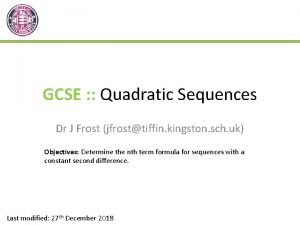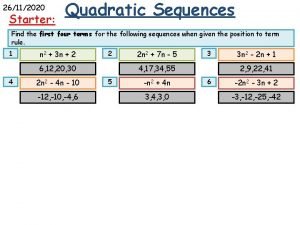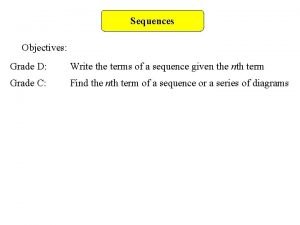Sequences Linear Quadratic Demonstration This resource provides animated
















- Slides: 16

Sequences – Linear & Quadratic – Demonstration This resource provides animated demonstrations of the mathematical method. Check animations and delete slides not needed for your class.

Linear Sequences difference +2 +2 +2 (Arithmetic Sequences) nth term formula 5, 8, 11, 14, … 3 n + 2 1 st term n=1 2 nd term n=2 4 th term 3 rd term n=4 n=3 In a linear sequence, the numbers increase/decrease by the same amount every time, just like a times table. We want to find a formula for the nth term. n = the position of the number (5 th, 6 th, 20 th, 1000 th)

Example 1 +2 +2 +2 +3 5, 7, 9, 11, … 2 4 6 8 1) What times table is hidden in the sequence? 2) What do we need to add/subtract to make the sequences match? nth term formula = (2 × n) + 3 = 2 n + 3 CHECK! n = 4 4 th = (2 × 4) + 3 = 11

Example 2 +4 +4 6, 10, 14, 18, … 4 8 12 16 1) What times table is hidden in the sequence? 2) What do we need to add/subtract to make the sequences match? nth term formula = (4 × n) + 2 = 4 n + 2 CHECK! n = 3 3 rd = (4 × 3) + 2 = 14

Example 2 +4 +2 +4 Your Turn +4 6, 10, 14, 18, … 4 8 12 16 +3 +3 +2 +3 5, 8, 11, 14, … 3 6 9 12 1) What times table is hidden in the sequence? 2) What do we need to add/subtract to make the sequences match? nth term formula = (4 × n) + 2 = 4 n + 2 CHECK! n = 3 3 rd = (4 × 3) + 2 = 14 nth term formula = (3 × n) + 2 = 3 n + 2 CHECK! n = 2 2 nd = (3 × 2) + 2 = 8

Example 1 − 2 +4 − 2 2, 0, − 2, − 4, … − 2 − 4 − 6 − 8 1) What times table is hidden in the sequence? 2) What do we need to add/subtract to make the sequences match? nth term formula = (− 2 × n) + 4 = − 2 n + 4 = 4 − 2 n CHECK! n = 4 4 th = 4 + (− 2 × 4) = − 4

Example 2 − 3 +5 − 3 2, − 1, − 4, − 7, … − 3 − 6 − 9 − 12 1) What times table is hidden in the sequence? 2) What do we need to add/subtract to make the sequences match? nth term formula = (− 3 × n) + 5 = − 3 n + 5 = 5 − 3 n CHECK! n = 4 4 th = 5 + (− 3 × 4) = − 7

Example 2 − 3 +5 − 3 Your Turn − 3 2, − 1, − 4, − 7, … − 3 − 6 − 9 − 12 − 2 − 2 +7 5, 3, 1, − 1, … − 2 − 4 − 6 − 8 1) What times table is hidden in the sequence? 2) What do we need to add/subtract to make the sequences match? nth term formula = (− 3 × n) + 5 = − 3 n + 5 nth term formula = (− 2 × n) + 7 = − 2 n + 7 = 5 − 3 n CHECK! n = 4 4 th = 5 + (− 3 × 4) = − 7 = 7 − 2 n CHECK! n = 4 4 th = 7 + (− 2 × 4) = − 1

Quadratic Sequences 1) Find the 2 nd difference & halve it to find the n 2 coefficient 2) Subtract the quadratic from the original sequence 3) Express the remainder as a linear sequence 4) Join the quadratic with the linear sequence +2 +4 +2 +6 +2 +8 Quadratic = 1 n 2 + 10 96, 10, 16, 24, 34 n 1 2 3 4 5 Original 6 10 16 24 34 Quadratic: 1 n 2 1 4 9 16 25 Remainder 5 6 7 8 9 1 n 2 + n + 4 n+4

Quadratic Sequences 1) Find the 2 nd difference & halve it to find the n 2 coefficient 2) Subtract the quadratic from the original sequence 3) Express the remainder as a linear sequence 4) Join the quadratic with the linear sequence +2 +5 +2 +7 +2 +9 Quadratic = 1 n 2 + 11 96, 11, 18, 27, 38 n 1 2 3 4 5 Original 6 11 18 27 38 Quadratic: 1 n 2 1 4 9 16 25 Remainder 5 7 9 11 13 1 n 2 + 2 n + 3

Quadratic Sequences 1) Find the 2 nd difference & halve it to find the n 2 coefficient 2) Subtract the quadratic from the original sequence 3) Express the remainder as a linear sequence 4) Join the quadratic with the linear sequence +2 +1 +2 +3 +2 +5 Quadratic = 1 n 2 +7 93, 4, 7, 12, 19 n 1 2 3 4 5 Original 3 4 7 12 19 Quadratic: 1 n 2 1 4 9 16 25 Remainder 2 0 − 2 − 4 − 6 1 n 2 − 2 n + 4

Quadratic Sequences 1) Find the 2 nd difference & halve it to find the n 2 coefficient 2) Subtract the quadratic from the original sequence 3) Express the remainder as a linear sequence 4) Join the quadratic with the linear sequence +4 +7 +4 + 11 +4 + 15 Quadratic = 2 n 2 + 19 96, 13, 24, 39, 58 n 1 2 3 4 5 Original 6 13 24 39 58 Quadratic: 2 n 2 2 8 18 32 50 Remainder 4 5 6 7 8 2 n 2 + n + 3 n+3

Calculate whether each sequence is linear, quadratic or neither. Use the nth term formula to find the value of the 7 th term. 6, 10, 14, 18, 22 5, 5, 10, 15, 25 1, 4, 7, 10, 13 6, 10, 16, 24, 34 2, 6, 18, 54, 162 3, 1, − 3, − 5 3, 3, 5, 9, 15 Start by finding 1 st / 2 nd differences

Calculate whether each sequence is linear, quadratic or neither. Use the nth term formula to find the value of the 7 th term. Start by finding 1 st / 2 nd differences 6, 10, 14, 18, 22 Linear 4 n + 2 5, 5, 10, 15, 25 Neither (Fibonacci-type) 1, 4, 7, 10, 13 Linear 3 n − 2 6, 10, 16, 24, 34 2, 6, 18, 54, 162 3, 1, − 3, − 5 3, 3, 5, 9, 15 7 th term = 30 7 th term = 19

Calculate whether each sequence is linear, quadratic or neither. Use the nth term formula to find the value of the 7 th term. Start by finding 1 st / 2 nd differences 6, 10, 14, 18, 22 Linear 4 n + 2 5, 5, 10, 15, 25 Neither (Fibonacci-type) 1, 4, 7, 10, 13 Linear 3 n − 2 7 th term = 19 6, 10, 16, 24, 34 Quadratic n 2 + n + 4 7 th term = 60 2, 6, 18, 54, 162 Neither (Geometric) 3, 1, − 3, − 5 Linear 5 − 2 n 7 th term = − 9 Quadratic n 2 − 3 n + 5 7 th term = 33 3, 3, 5, 9, 15 7 th term = 30

Questions? Comments? Suggestions? …or have you found a mistake!? Any feedback would be appreciated . Please feel free to email: tom@goteachmaths. co. uk
 Arithmetic sequence
Arithmetic sequence Dr frost maths sequences
Dr frost maths sequences Equation for quadratic sequence
Equation for quadratic sequence Quadratic sequences worksheet
Quadratic sequences worksheet Site:slidetodoc.com
Site:slidetodoc.com Animated donuts
Animated donuts Data flow animation
Data flow animation Be scared
Be scared Animated scene maker
Animated scene maker Tensionless hitch
Tensionless hitch The tempest shakespeare film
The tempest shakespeare film Animated assembly video
Animated assembly video Plant cell animated
Plant cell animated Animated liquid sunset
Animated liquid sunset Animated reading
Animated reading Define social science
Define social science Verify adjective
Verify adjective































